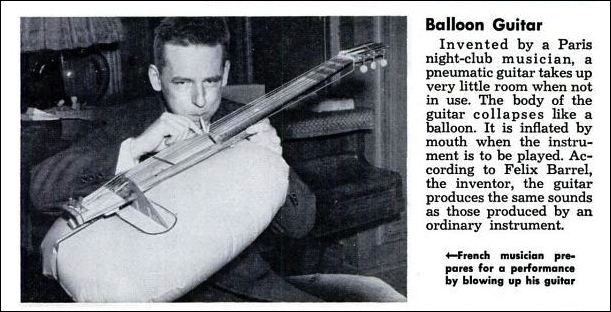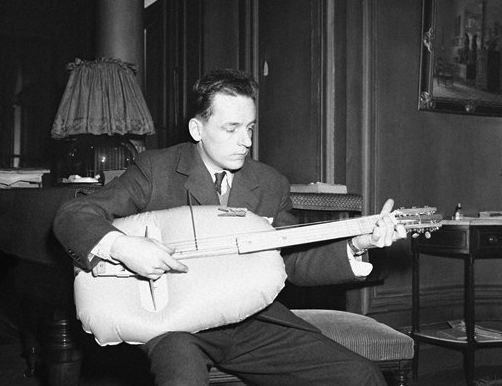Patents
The Gnathograph
The Gnathograph, or 'dental articulator', was the invention of Los Angeles dental surgeon Beverly McCollum. He was also the founder, in 1926, of the Gnathologic Society.The name 'Gnathograph' derived from 'gnathology,' this being the study of the jaw and masticatory system, from the greek word 'gnathos' meaning 'jaw'.

"The formidable contraption shown in the mouth of Miss Pearl Nord is a gnathograph, invented by Dr. Beverly B. McCollum of Los Angeles and demonstrated before the chicago Dental Society. It records direction of bite and fit of teeth and accurately guides a dentist in straightening crooked teeth or fitting inlays, crowns, bridges and plates."
image source: Agi Haines

The band Femur used the image above from Popular Science as the cover art for their album Red Marks.

Posted By: Alex - Sun Oct 03, 2021 -
Comments (0)
Category: Inventions, Patents, 1930s, Teeth
Martian Blood Concrete
Researchers at the University of Manchester have proposed that future settlers on Mars can create concrete by mixing Martian dust with their own blood and urine. Details from globalnews.ca:The blood-and-dust mixture alone is equivalent to concrete, but researchers say it becomes even stronger when human urea is added to the mix...
Roberts and his team say that animal blood could eventually replace human blood in Martian construction projects, but that would only happen after we send cows to Mars.

Experimental 'astrocrete' made from blood and dust
We've posted before about the use of blood to make concrete. Charles Laleman was granted a patent for this in 1980, but the practice goes all the way back to Roman times.
Posted By: Alex - Sat Oct 02, 2021 -
Comments (0)
Category: Architecture, Patents, Space Travel, Blood
Felix Barrel’s Pneumatic Guitar
I originally posted this back in Oct 2012, but I was recently contacted by Matt Nolan who informed me that the info in the post wasn't entirely accurate. 'Felix Barrel' was actually the tongue-in-cheek stage name of François Baschet, who was granted both a French and US patent for his invention. Also, he invented it in 1952, not 1955.The picture of Baschet with his guitar can be found on the website of the Baschet Association, which explains that its invention was just the start of Baschet's long career as a creator of unusual instruments, particularly ones that involved "folding metal sheets into geometric shapes".
Thanks to Matt for the info!
Back in
Posted By: Alex - Sat Sep 25, 2021 -
Comments (8)
Category: Music, Patents, 1950s
Ralph Woltstem’s Breast Supporters
Back in the 1920s, Ralph Woltstem reimagined the brassiere. He did away with the straps around the shoulders and instead used columns to provide support from below. These columns, in turn, incorporated shock absorbers. He was granted two patents for this invention. The device in both patents looks pretty much identical to me. The images are from Patent No. 1762676, and the explanatory text below is from Patent No. 1741898: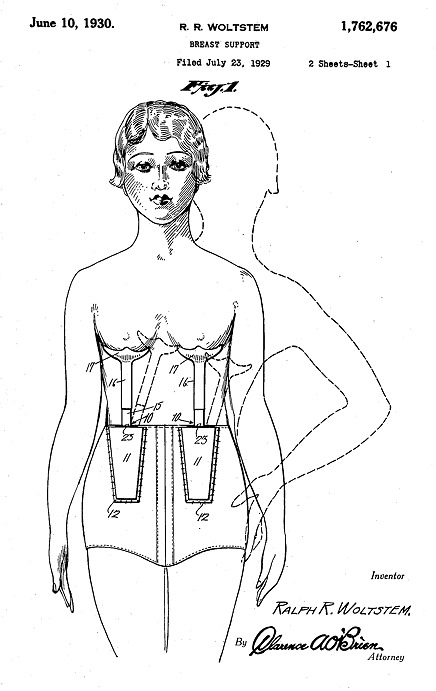
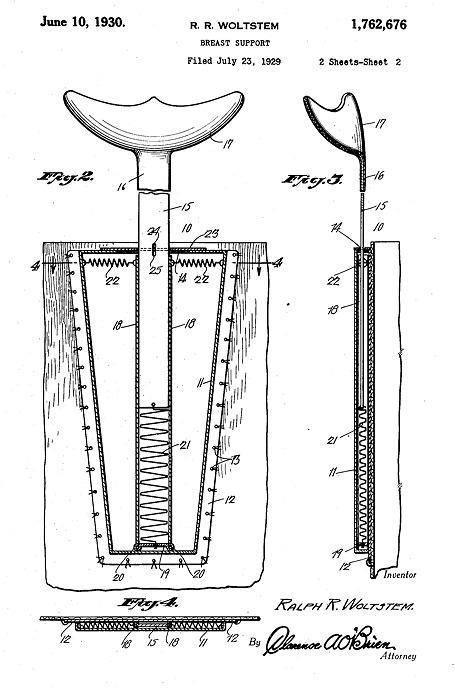
Posted By: Alex - Sun Sep 19, 2021 -
Comments (3)
Category: Patents, Underwear, 1920s
AutoVision
Back in the 80s and 90s, Jay Schiffman had big hopes for his AutoVision system, which allowed a person to watch TV while driving a car. His device projected the image onto a small mirror positioned on the windshield, so that the driver could look at the road and a TV show simultaneously.Schiffman always insisted that AutoVision actually made driving safer, not more dangerous. From the Chicago Tribune (Sep 6, 1998):
In addition, the images kept the drivers alert, he said, stimulating their sympathetic nervous system, or fight-or-flight response.
I don't think many people were convinced by his argument. But maybe self-driving cars will create a new market for his invention.
More info: Patent No. US5061996A; "TV for Cars" Popular Science (Dec 1990)


Newport News Daily Press - May 15, 1998
Posted By: Alex - Fri Sep 10, 2021 -
Comments (0)
Category: Television, Patents, Cars
Boiled Fish Paste Crust Pizza
In 2014, the Korean patent office granted a patent for "a manufacturing method of boiled fish paste crust pizza."Doesn't sound appetizing to me, but perhaps boiled fish paste is popular in Korea.

Posted By: Alex - Mon Sep 06, 2021 -
Comments (1)
Category: Inventions, Patents, Junk Food
Banana-Shaped Writing Device
Kia Scudder of San Antonio, Texas was recently granted Patent No. 11077701 for a "banana shaped writing device and method." From the patent:

Posted By: Alex - Fri Sep 03, 2021 -
Comments (2)
Category: Inventions, Patents, Bananas
Round Hot Dogs
Hot dogs shaped like hamburgers. So you don't have to buy separate hot dog and hamburger buns. Available from Rastelli's.The inventors of these think they're unique enough to be patentable. But their patent application is still pending.
More info: philly grub blog

Posted By: Alex - Tue Aug 24, 2021 -
Comments (7)
Category: Patents, Junk Food
Madeleine Ravier’s Bicycle for Animals
Humans have invented mechanical devices, such as bicycles, that allow us to move faster by amplifying the power of our limbs. Madeleine Ravier of Paris argued that what works for people should also work for animals. So she invented and, in 1907, patented a "Cycles pour animaux," or 'bicycle for animals'.Her patent is in French, but the automatic translation is fairly comprehensible. Here's part of it.
Quite recently (less than 50 years ago), understanding the imperfection of his own limbs, he endowed them with mobile mechanisms, he put cycles, devices formed of 2 or 3 wheels between the legs. and of a few light and simple organs, with which he has prodigiously increased the extent of his movements without the help of external energy.
He thus achieved 370 kilometers in 12 hours (cyclist Cadolle), and even 45,764 kilometers (record of cyclist Bouhours), while excellent athletes, on their limbs, did not achieve, at most, at the same time of 12 hours than the already very high distances of 113 kilometers (walker 5o Hibbird) or ikh kilometers (rowell runner)....
What man did for himself he can do it for animals, or at least for some of them; There is a way to increase the efficiency of their limbs by the intercalation, between these limbs and the field of motion, of mechanical devices receiving the reciprocating motion of the limbs, transforming it into continuous rotary motion, and ending in rotating parts; and the result obtained can be used to make animals move man faster and farther than has hitherto been done by using them.
Ravier imagined making bicycles for all kinds of animals including "mules, donkeys, elephants, camels, dromedaries, etc.". But she started with a bicycle for horses, as shown below.

I have no idea if she ever built and tested one of these horse bicycles. The language barrier makes researching this a challenge.
Posted By: Alex - Sun Aug 08, 2021 -
Comments (5)
Category: Animals, Bicycles and Other Human-powered Vehicles, Inventions, Patents, 1900s
Square-Wheeled Tank
In 1957, Albert Sfredda secured a patent (No. 2,786,540) for a square-wheeled tank. He explained: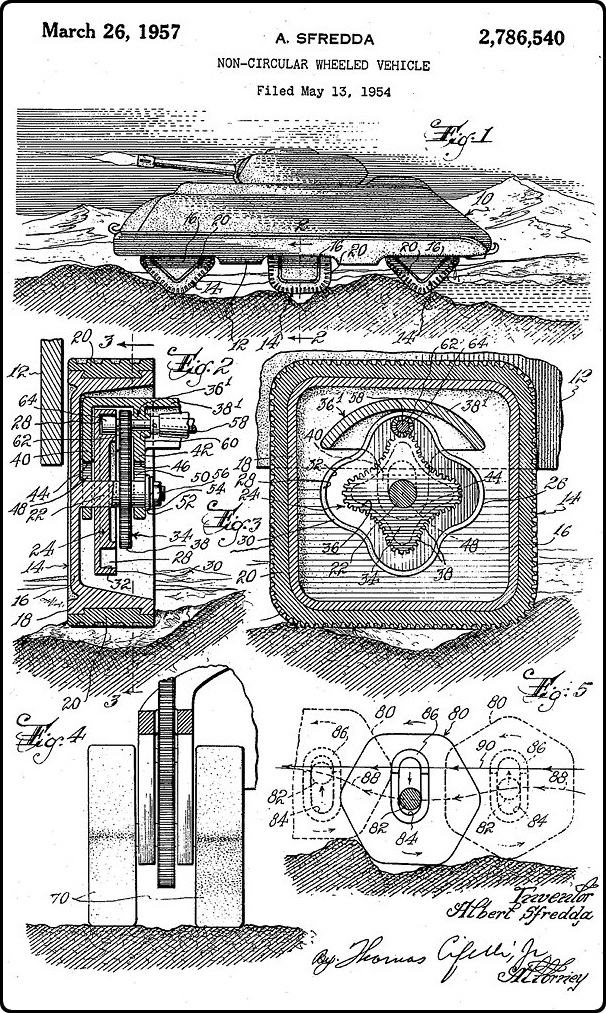
Sfredda was correct that square wheels would provide better traction on rough terrain than circular wheels would. The video below explains why. But the problem, of course, was that his tank would have difficulty moving on a regular, flat road.
Along similar lines, Macalester College has had a square-wheeled bicycle on permanent display since 1997. More info: macalester.edu
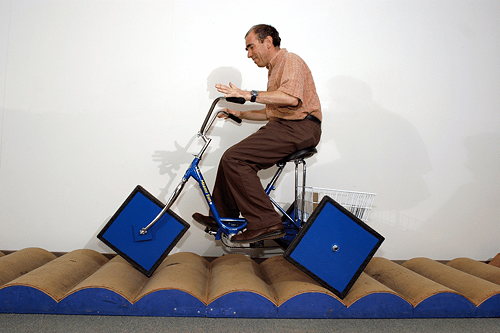
image source: StanWagon.com
Posted By: Alex - Wed Jul 21, 2021 -
Comments (2)
Category: Motor Vehicles, War, Weapons, Patents, 1950s

| Who We Are |
|---|
| Alex Boese Alex is the creator and curator of the Museum of Hoaxes. He's also the author of various weird, non-fiction, science-themed books such as Elephants on Acid and Psychedelic Apes. Paul Di Filippo Paul has been paid to put weird ideas into fictional form for over thirty years, in his career as a noted science fiction writer. He has recently begun blogging on many curious topics with three fellow writers at The Inferior 4+1. Contact Us |

